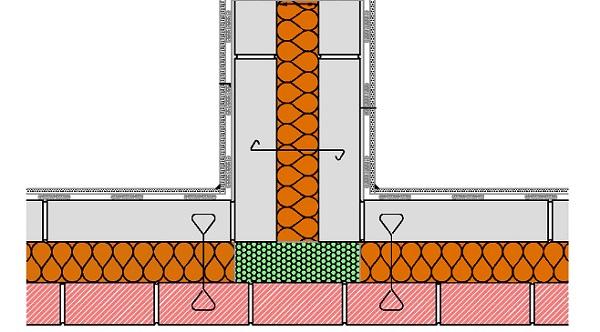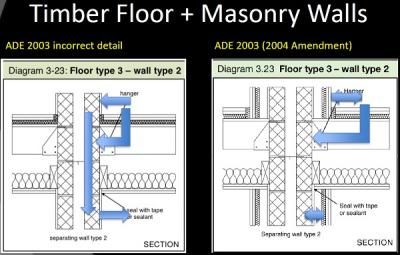How to comply with Building Regulations Part E: Design and specification key to noise problems
New dwellings that fail the acoustic test can costs many thousands of pounds to correct. So getting the design and specification right before construction is really sensible.
Sound is effectively an audible vibration, and when a sound wave hits a surface some of its energy will be reflected and some absorbed. Understanding how sound vibrations are transmitted in buildings has been instrumental in reducing complaints of unwanted noise transfer in dwellings.
Approved Document E for England and Wales provides guidance on the minimum standards for the sound insulation that separating walls and floors offer between dwellings, and also for internal walls and floors separating rooms within dwellings. It sets similar standards for other types of residential rooms such as hotel rooms.
Separating walls, floors and ceilings
The legislation is concerned with protecting residents from nuisance noise in attached dwellings and within the dwelling itself and so it requires separating walls and floors to be built in order to provide specific levels of protection. Planning policy documents (such as the National Planning Policy Framework) should be consulted when it comes to protecting dwellings from external noise sources, such as road or air traffic.
The passage of sound in a building can be controlled through the design of wall and floor constructions, which will absorb sound. A construction element’s ability to resist the passage of airborne sound energy is largely determined by the following factors:
- The sound absorbency of any cavities in the construction
- The structural isolation between the two outer surfaces
- The mass of the structure
- The air tightness of the construction
Acoustic absorption
Absorbing airborne sound in the cavity and reducing reverberation is vital and glass mineral wool insulation offers good acoustic absorption performance. Its use in carefully specified constructions with good detailing contributes significantly towards the requirements stipulated across the building regulations.
In partitions, glass mineral wool complements the plasterboard linings by absorbing airborne sound in the cavity and reducing reverberation. It is particularly effective at preventing the hollow sound that can occur in partitions with unfilled cavities.
Impact noise presents a different problem and requires different solutions. Impact noise is created by knocking sounds or walking on party floors (high heels on laminate are particularly guilty!) and can be controlled through structural isolation such as adding a resilient mineral wool or rubber layer between the floor deck and the floor structure.
When building new party walls and floors it's usually necessary to have them tested at completion by a qualified acoustician. This is when the design, detailing and construction quality is really found out.
The consequences of failing a sound test can be very costly in terms of time and money, and therefore we would always recommend that the design and construction is strictly in accordance with the details in Approved Document E or with a manufacturer’s specified solution.
Have your project tested by LABC Acoustics. Remember, with soundproofing the devil is in the detail!
See what services LABC Acoustics can provide for you
If you liked this article you might find these links useful:
Please Note: Every care was taken to ensure the information was correct at the time of publication. Any written guidance provided does not replace the user’s professional judgement. It is the responsibility of the dutyholder or person carrying out the work to ensure compliance with relevant building regulations or applicable technical standards.
This article was updated on August 2024
Sign up to the building bulletin newsletter
Over 48,000 construction professionals have already signed up for the LABC Building Bulletin.
Join them and receive useful tips, practical technical information and industry news by email once every 6 weeks.
Subscribe to the Building Bulletin





Comments
Upstairs flat - FEB 2017, removed Carpet & installed Lino floor
Submitted 6 years ago
So if my neighbour is at fault for not following the 43db airborne and 64 decibel impact, what association / enforcement association can i appeal to ?
alex.borriello@gmail.com - 07515809314
Reply to: Upstairs flat - FEB 2017, removed Carpet
Submitted 6 years ago
It would be best to seek advice from your local building control team. You can find them here: https://www.labc.co.uk/your-local-council-building-control-department — simply enter your postcode and click 'Search'.
Regards,
LABC
db rating
Submitted 6 years ago
A. domestic flats
B. Commercial space
Reply to: db rating
Submitted 6 years ago
Thank you for your query.
In this instance, it would be best to direct your query to LABC Acoustics who will be able to advise. The contact number for LABC Acoustics is 0121 2703333.
Kind regards,
LABC
Thompson
Submitted 5 years 11 months ago
dividing properties
Submitted 5 years 11 months ago
Reply to: dividing properties
Submitted 5 years 11 months ago
You will actually be carrying out building work defined as a 'change of use' so a building regulations application will be required. You may also need planning permission.
The party walls you plan to create will be subject to a number of requirements but particularly fire, thermal and sound. You can find more information in Approved Document E Wall type 4 (page 39) and your designer will be able to advise on its interface with the existing construction at floor and ceiling levels.
Whilst a stud wall may be capable, you still will require technical expertise prior to construction to ensure that the proposed specification will meet requirements otherwise remedial work, particularly in relation to sound, will be both expensive and difficult to achieve.
You should consult with your local authority building control team to discuss your requirements. Find their details by entering the postcode of your project in the 'find your council' bar at the top of our website.
Kind regards,
David, LABC
Detached house noise
Submitted 5 years 10 months ago
Just bought new detached house and it’s noisy. Not quite clear what elements of Building Regs Part E2 apply to detached houses. Could do with advice and possible testing please.
Reply to: Detached house noise
Submitted 5 years 10 months ago
Your local building control team will be pleased to provide advice. You can find them by entering the postcode of your property in the 'find your council' bar at the top of our website.
Kind regards,
LABC
Transmission of vibrations from washing machine from adjoining
Submitted 5 years 10 months ago
Ychwanegu sylw newydd